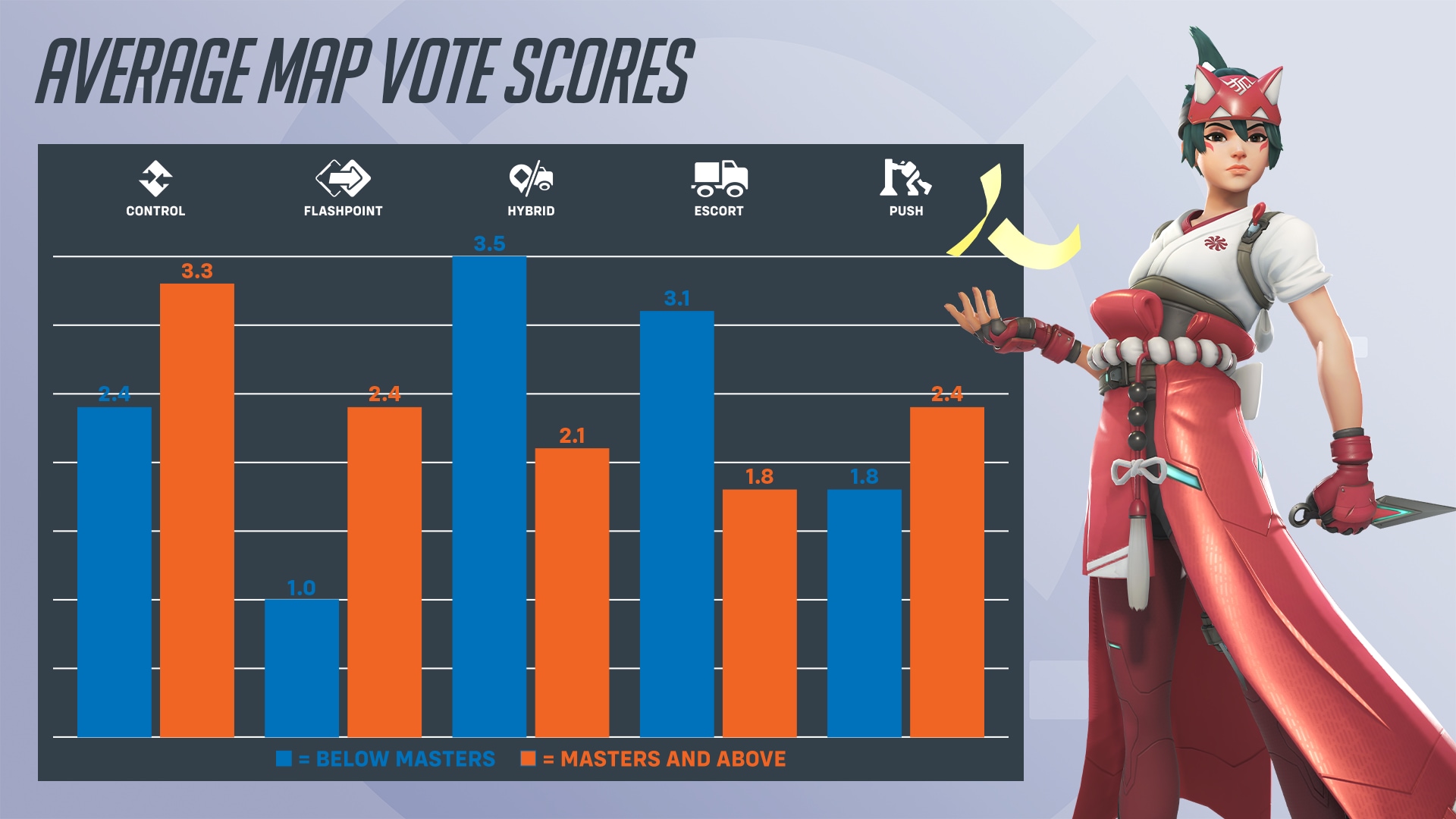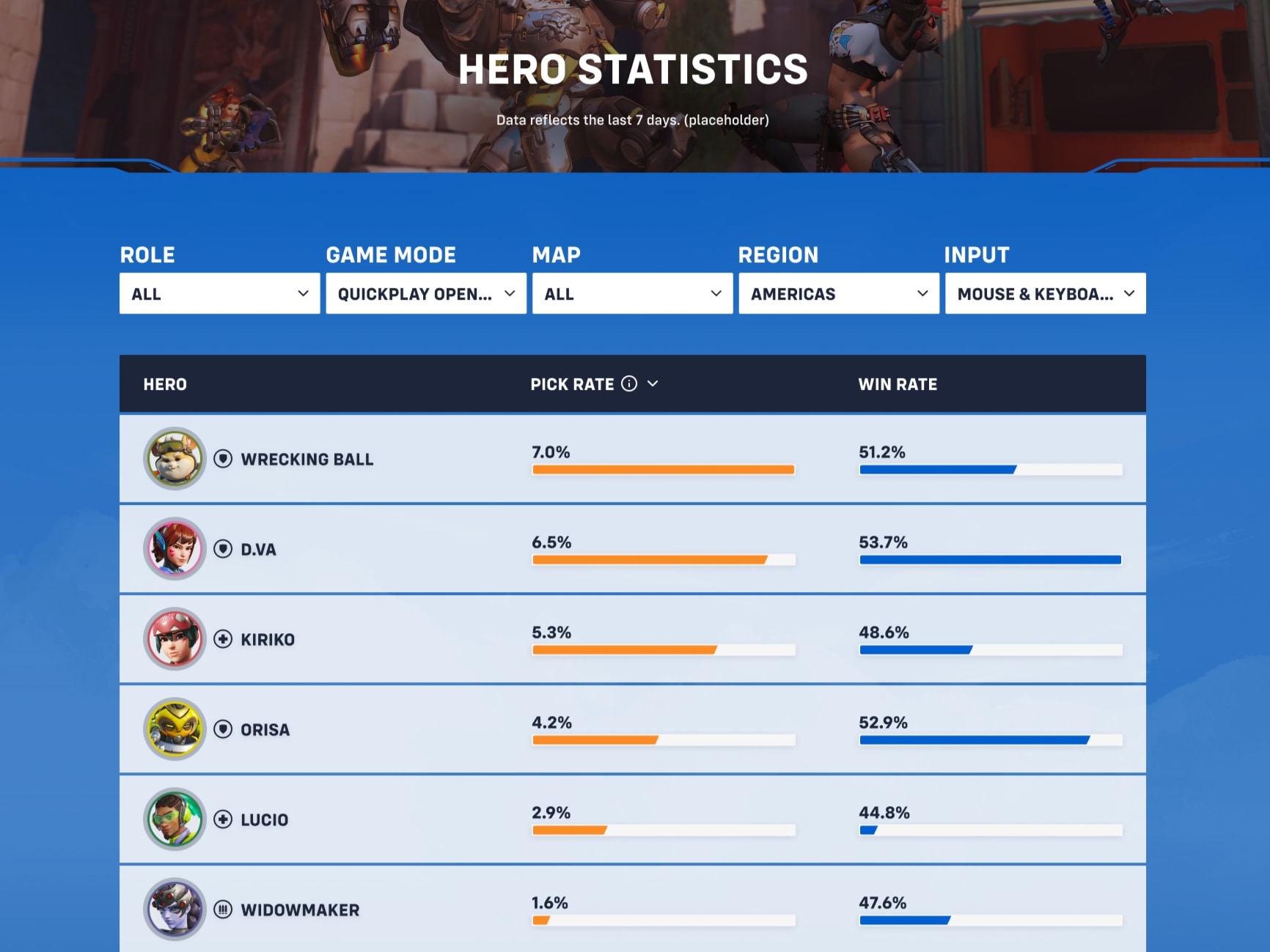Hey everyone! I’m back with another philosophically-flavored Director’s Take that tackles an important set of goals we’re trying to accomplish on the Overwatch team: more transparency, more information, and more power to you.
Map Voting data is an excellent example of these goals in action. We regularly hear from more vocal players about their personal experiences, which can then lead other players to believe that’s the reality for everyone. At Competitive ranks above Masters 5, Control is the most popular map mode, followed by Flashpoint and Push. But when you look at ranks below Masters 5—where most players (statistically) spend their time—Hybrid is the most-played mode and Flashpoint is the least-selected mode.

So, if you’re in Silver and convinced you’re always playing Hybrid maps and your friend is in Masters, convinced they rarely see Hybrid maps, you’d both be correct based on the reality built by your personal Overwatch environment. That environment creates a reality around you that’s entirely factual, at least from where you’re standing.
This is something we often consider when implementing improvements and changes to Overwatch. Some changes, like balance tuning, might feel odd if you aren’t in the rank threshold we are targeting with a specific adjustment. With that in mind, we’ve been thinking about what we can do to broaden your perspective.
Learning And Discovery
I might be aging myself here, but do you remember when all the answers to a brand-new video game weren’t instantly accessible? When I used to go to local fighting game tournaments, and someone whipped out a new combo, we’d all learn it in real time, as a community, and add it to our repertoire.
Things have changed over the years, but as designers we still like to chase that experience through deep discovery windows. Think of discovery windows as the amount of time it takes players to “figure out” the best ways to handle big changes, like new Perks or new Heroes. It’s that time where everyone is learning together and things aren’t min-maxed yet. Things can feel a little messy, but that’s part of what makes discovery windows special. The discovery window is my personal favorite time in games: everyone throws theories and ideas at the wall to see what sticks and experimentation leads to innovation that can even surprise (and inspire!) our team.
Social media can be a double-edged sword when it comes to discovery windows. Nothing brings a community together more than working through the same “puzzle” and trying new strategies with friends and teammates, so the conversation after an impactful update is always amazing to see. On the other hand, there always seems to be a race to “crack the code” of a new patch, and many people market their solution as the best option.
This isn’t necessarily a bad thing: it’s reasonable for people to seriously consider what they’re playing and how to maximize their success. But there’s an innate risk of cutting your own discovery window—and the joy of that process—when you simply accept answers handed to you instead of seeking your own solutions.
When information is available to everyone equally, the opportunity to make your own judgements is also distributed equally.
Armed With Truth
Offering you more real-time information about Overwatch may risk cutting that discovery window on our end, but our team is willing to take that risk in hopes that providing more visibility leads to a deeper understanding of what we do and why we do it. Is there a way to do that by making the discovery window easier to navigate?
We think so. An upcoming website we’ve been working on with the Battle.net team—called Hero Stats—will also offer information many of you have been fiending for. Win rates, pick rates, and other deep dive data will soon be available for everyone to analyze, and we can’t wait to see what the community does with all those beautiful numbers. Here’s a sneak peek from the team with placeholder (not real) data!

Data displayed is not actual game data and for demonstrative purposes only.
In addition to being able to source data online, we’re also keen on giving you more information inside Overwatch. We don’t want to give too many Season 18 spoilers away, but one feature we think you’ll be really excited about is the Advanced Info Panel. Ever wondered about the falloff range of Cassidy’s weapon, or the exact amount of headshot damage Hanzo’s Storm Bow does? You’ll soon be able to find that out without leaving the game client. Our next Developer Update will have all the details.
As a bonus, seeing the same concrete data our development team uses may help you better understand balance changes and tuning that might not directly apply to your personal Overwatch environment. Remember, data isn’t the only thing we base balance changes on (that’d be a combination of intuition, feedback, and data), but this should help to understand what the data looks like when those decisions are made.
Our goal is to keep Overwatch approachable and easy to pick up for new players, but that doesn’t mean those who crave more complex information can’t have that option. The team and I believe that you’re better off having the information put in front of you, so you can choose how you want to use it to broaden your perspectives, increase your personal knowledge, and level up your own Overwatch experience.
Thanks for reading! Good game and remember to endorse your tanks.
Source link

